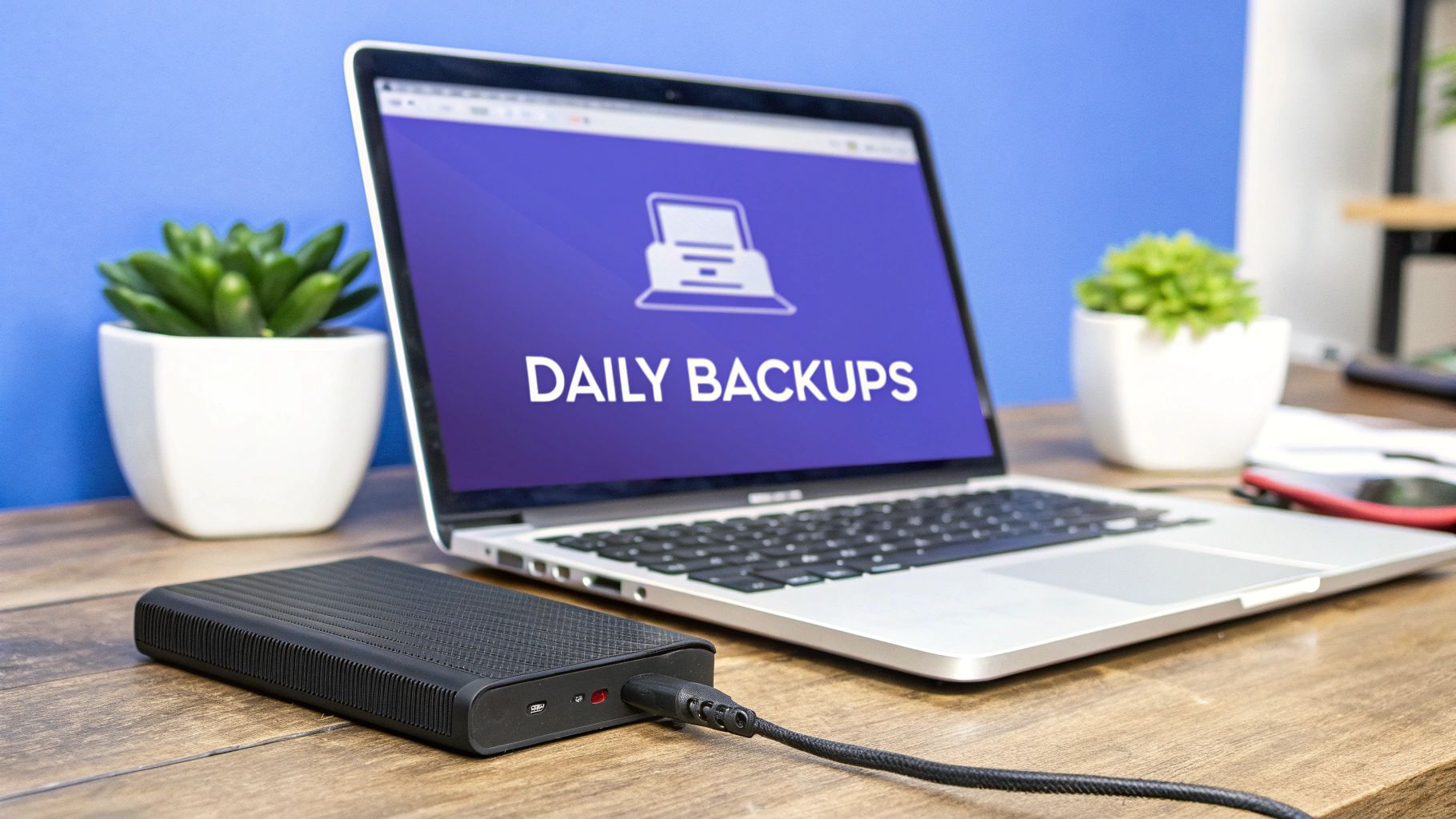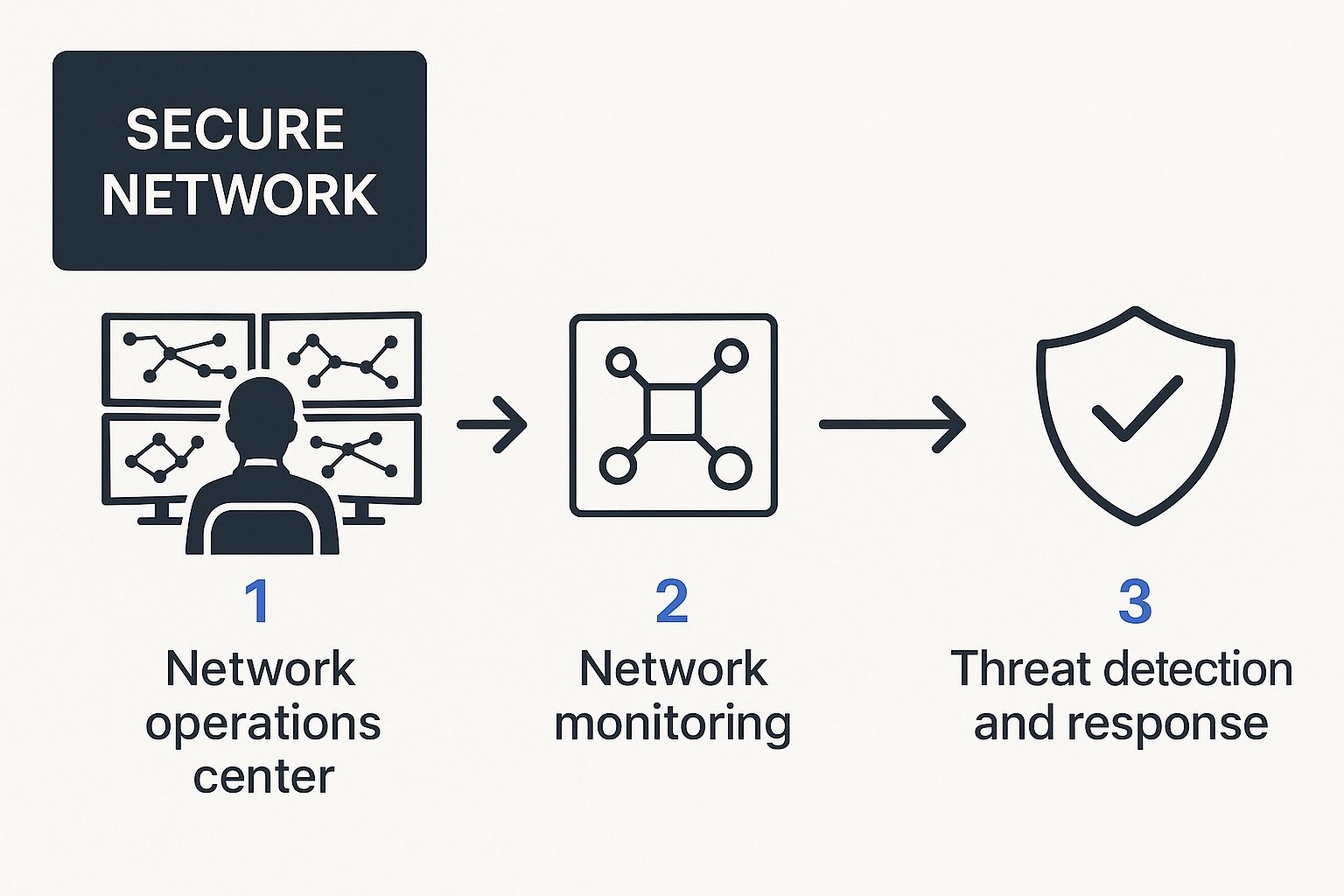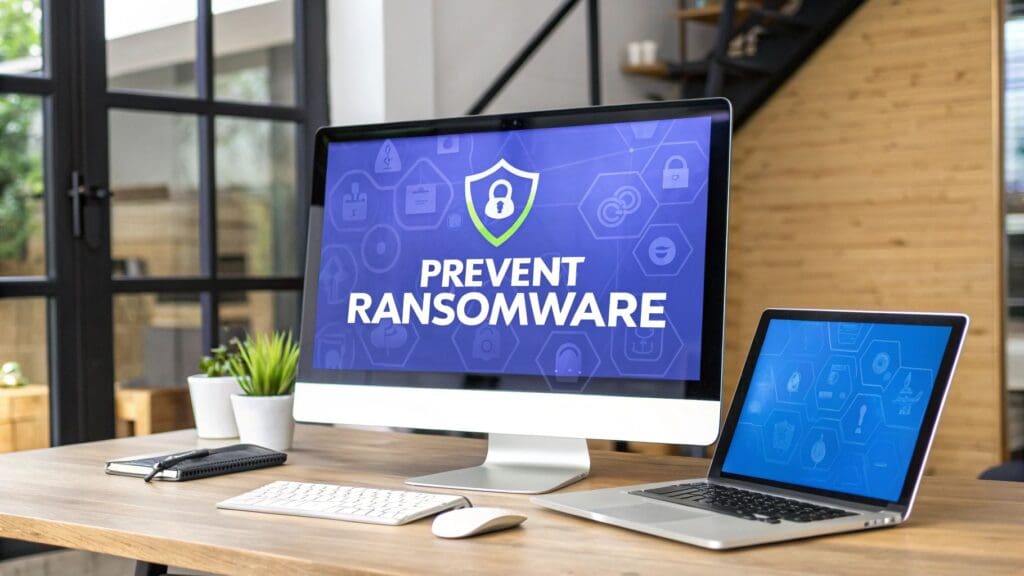Dealing with ransomware isn't about buying a single piece of fancy software. It’s about building a multi-layered defence focusing on smart backups, consistent software updates, practical team training, and the right security tools. By weaving these strategies together, creative agencies can build a robust barrier against digital extortion, making it far harder for attackers to get a foothold.
Your Agency's Defence Against Digital Extortion

For a creative agency, the threat of ransomware is more than just an IT headache- it's a direct assault on your most valuable assets. Your client data, project files, and unique intellectual property are the very things that make your business tick. A successful attack can bring projects to a grinding halt, shatter client trust, and cause devastating financial and reputational damage.
It's time to move past fear and into action. This guide lays out a clear, practical plan to harden your defences. Forget complex jargon or enterprise-level budgets; this is all about implementing effective measures that fit the real-world workflow of a creative studio.
Understanding the Threat You Actually Face
These attacks are getting more common, and it's not just the big fish being targeted. The UK Cyber Security Breaches Survey noted that around 1% of all UK businesses suffered a ransomware attack last year. That’s a sharp jump from less than 0.5% the year before. This is part of a wider trend, with half of all UK businesses reporting some form of cyber-attack or breach.
This data proves that agencies of all sizes are on the radar. In fact, attackers often see smaller businesses as softer targets, banking on the assumption that they lack dedicated security resources.
The hard truth is that most ransomware attacks are automated and indiscriminate. They aren't necessarily targeting you specifically- they're just rattling every digital doorknob they can find. Your job is to make sure yours are securely locked.
Core Defence Pillars for Creatives
To build a truly effective ransomware defence, you need to focus your energy on four key areas. Think of them as pillars holding up your security structure- each one is critical, and they support each other.
To give you a clearer picture, here’s a quick summary of the essential strategies every creative agency should be implementing.
Core Ransomware Defence Pillars at a Glance
| Pillar | Primary Goal | Key Action |
|---|---|---|
| Smart Backup Strategies | Make paying a ransom an irrelevant, obsolete option. | Implement the 3-2-1 rule with a mix of local, cloud, and offsite (air-gapped) backups. |
| Consistent Software Updates | Close the security holes attackers love to exploit. | Enable automatic updates and create a schedule for patching all software and systems. |
| Practical Employee Training | Turn your team into a vigilant line of defence. | Run regular, real-world phishing simulations and security awareness training. |
| Essential Security Tooling | Use modern tech to block threats automatically. | Deploy next-gen antivirus, a solid firewall, and DNS filtering to block malicious sites. |
By addressing these pillars, you create a formidable defence that works around the clock.
- Smart Backup Strategies: Make paying a ransom a ridiculous idea by ensuring you can always restore your data, no matter what happens.
- Consistent Software Updates: Close the security gaps that attackers exploit by keeping every piece of software you use fully patched. No exceptions.
- Practical Employee Training: Transform your team from a potential vulnerability into a vigilant first line of defence against phishing and social engineering tricks.
- Essential Security Tooling: Use modern technology to automatically detect and block threats before they can do any damage.
If you're looking to dive deeper into protecting your business, this essential guide to cybersecurity for small businesses is an excellent resource. It provides a solid foundation for any agency serious about strengthening its security framework.
Transform Employees into Your First Line of Defence

Your technical defences are crucial, but let's be honest- the human element is often the most targeted link in your security chain. Attackers know that a well-crafted email can sail right past even the most advanced firewalls. To truly prevent ransomware, you have to turn your team from a potential target into a vigilant, proactive defence force.
This isn’t about a tick-box, once-a-year training session. Real education is continuous, practical, and directly relevant to the threats your creative agency faces day in, day out.
Running Realistic Phishing Simulations
One of the most effective training tools I've seen in action is the simulated phishing campaign. These are controlled tests that mimic real-world attacks, teaching your staff to spot suspicious emails in a completely safe environment. It’s the difference between telling someone what to look for and actually showing them.
You can use accessible tools to create convincing fake emails. Think of things your team sees every day: client updates, software notifications from your creative suite, or even internal IT alerts. The goal isn't to trick or punish anyone; it's about building muscle memory for scepticism. When a real threat lands in their inbox, their reaction will be instinctual.
A critical part of how to prevent ransomware attacks involves shifting your team's mindset from passive trust to active verification. Every unexpected request for credentials, data, or payment should trigger a moment of pause and a quick check-in.
This approach is more important than ever. In the UK, ransomware attacks have surged, largely driven by phishing. It's a sobering fact that nearly 30% of phishing emails are opened, massively increasing the risk of infection. Between 2020 and 2021, ransomware and business email compromise were responsible for 44% and 50% of financial losses from cybercrime, respectively. You can dig into the numbers in this report on ransomware attack statistics.
Creating a Clear Reporting Process
So, what happens when an employee spots something that looks off? A vague instruction to "be careful" just doesn't cut it. You need a simple, non-punitive process that actually encourages them to report it.
Give your team a clear checklist to follow if they suspect a phishing attempt:
- Do not click any links or download attachments. This is the golden rule.
- Do not reply to the sender. Replying only confirms your email address is active, which invites more attacks.
- Forward the suspicious email to a designated person or mailbox (like
[email protected]). This allows your IT support to analyse the threat properly. - Delete the original email from their inbox. This simple step prevents any accidental clicks later on.
A process like this removes fear and uncertainty. It empowers your team to become active participants in the agency's security, turning a potential disaster into valuable intelligence. As creative work increasingly involves remote collaboration, understanding these risks is paramount. For more on this, check out our guide on the top cybersecurity risks of remote work and how to address them. Fostering this culture of vigilance is a powerful- and surprisingly low-cost- way to bolster your security.
Build a Bulletproof Data Backup and Recovery Plan
Ransomware only works when you have no choice but to pay. A robust, regularly tested data backup and recovery strategy makes paying the ransom a non-issue. It’s your ultimate safety net, ensuring that even if an attacker slips through, you can restore your operations without giving criminals a single penny.
For creative agencies juggling massive project files and sensitive client data, a generic backup plan just won't cut it. The real goal here is to make data recovery a calm, practiced drill- not a panicked, chaotic scramble.
This image gives you a high-level view of how to think about securing your network, which is a core part of protecting your backup infrastructure.

Visualising your network security helps you see exactly where your backup systems fit in and, more importantly, how they need to be shielded from the very threats they're designed to save you from.
Embrace the 3-2-1 Backup Rule
The gold standard for data protection has always been the 3-2-1 rule. It’s a simple concept on the surface but incredibly powerful when you get it right. Think of it as building layers of redundancy so you can always, always get your data back.
Here’s how it breaks down for a creative agency:
- Three Copies of Your Data: This is your live, primary data plus two separate backups. Never rely on a single backup; if it fails or gets corrupted, you’re right back where you started.
- Two Different Media Types: Don't save all your copies on the same kind of kit. For an agency, a great setup is having one backup on a local Network Attached Storage (NAS) device and another in the cloud. This protects you if one type of media gives up the ghost or is compromised.
- One Copy Off-site: This is the most critical piece of the puzzle for ransomware defence. If your office gets hit, an off-site or "air-gapped" backup is physically disconnected and safe from the attack. Cloud storage is a fantastic, practical solution for this, especially for those huge design and video files.
The core idea is to eliminate single points of failure. If a ransomware attack encrypts your main server and your on-site NAS, that isolated cloud backup remains untouched and ready to get you back in business.
An Untested Backup Is a Failed Backup
Look, creating backups is only half the job. The step that so many businesses skip is regularly testing them. You absolutely must know, with 100% certainty, that you can restore your files when you need them most.
A realistic testing schedule is all you need- it doesn't have to be a huge, complicated affair. A simple monthly check, like trying to restore a random project file or a client folder, is often enough to prove your systems are working. It builds confidence and helps you iron out any kinks in your process. A well-rehearsed recovery plan is a cornerstone of business continuity, and you can learn more about building a complete strategy by reading our guide on what disaster recovery is.
Making this a routine turns a potential crisis into just another manageable task on the to-do list.
Alright, let's get down to the brass tacks. Policies and training are crucial, but they need to be backed up by the right tech working tirelessly in the background. Think of these as the digital guardians protecting your most valuable assets: your client work and your agency's intellectual property. Without them, even the most vigilant employee is fighting an uphill battle.
First up, your security software. I'm not talking about the traditional antivirus you installed a few years ago. That's simply not enough to stop modern ransomware. You need a proper anti-malware and antivirus suite that includes specific, behaviour-based ransomware protection. These advanced tools don't just hunt for known viruses; they actively monitor for suspicious activity, like a program suddenly trying to encrypt thousands of files at once. That's the signal of a ransomware attack, and a good system will shut it down cold before the damage is done.
Isolate Threats with Network Segmentation
Here’s one of the most effective, yet surprisingly overlooked, technical controls: network segmentation. It sounds complicated, but the concept is dead simple. You just divide your network into smaller, isolated zones so that if an intruder gets into one area, they can't move freely across your entire system. It's like a submarine with watertight compartments; if one section is breached, the doors seal to protect the rest of the ship.
A perfect, real-world example for any creative agency is how you set up your Wi-Fi.
- Main Agency Network: This is your inner sanctum. It's exclusively for employees to access internal servers, project files, and critical business apps. It needs to be locked down.
- Guest Wi-Fi Network: This should be a completely separate, isolated network for clients, visitors, and personal devices. Someone logging onto your guest Wi-Fi should have absolutely no way to even see, let alone access, anything on your main company network.
This simple split is incredibly powerful. It prevents a visitor's compromised laptop or an employee's personal phone from becoming a launchpad for an attack on your core infrastructure.
The Power of Multi-Factor Authentication
If you do only one thing after reading this guide, make it this: enable Multi-Factor Authentication (MFA) on every single critical account. MFA adds a second layer of verification on top of a password, usually a code from a phone app or a text message. It's one of the single most effective security measures you can implement.
Imagine a thief steals your house key. If you only have a standard lock, they can walk right in. But if you have a deadbolt that requires a separate, unique key (your MFA code), that stolen house key is suddenly useless.
This small step can single-handedly block an attacker who has stolen an employee's password. The recent explosion in ransomware attacks proves just how vital this is. For instance, the UK's healthcare sector saw a staggering 63% increase in publicly reported ransomware attacks in just one quarter, making it the most targeted industry. You can learn more about these recent ransomware trends and see why attackers are having so much success.
Make sure you enforce MFA on everything that matters:
- Email Accounts: This is your agency's central nervous system and a prime target.
- Project Management Tools: Protects your project timelines, client comms, and deadlines.
- Cloud Storage: Secures all your work-in-progress files and archived projects.
- Admin Accounts: Absolutely essential for your website, servers, and any software-as-a-service (SaaS) platforms you rely on.
Putting these technical controls in place- modern security software, network segmentation, and universal MFA- creates multiple layers of defence. It makes your agency a much harder, less appealing target for attackers who are always on the lookout for an easy payday.
Develop a Simple Patch Management Routine
Think of software updates as routine digital hygiene. An unpatched vulnerability is an open door for attackers, and it’s one of the simplest and most common ways they get inside a network. Closing these doors before criminals even have a chance to rattle the handles is one of the most effective, low-cost ways to stop a ransomware attack in its tracks.
The most infamous ransomware attack in recent memory, WannaCry, crippled organisations worldwide, including NHS hospitals right here in the UK. It exploited a known vulnerability in outdated versions of Microsoft Windows for which a patch was already available. It’s a stark reminder that delaying updates can have catastrophic consequences.
Make Patching a Priority
For a busy creative agency, I get it- managing updates across every single piece of software can feel completely overwhelming. The key isn't to be perfect, but to create a simple, repeatable process for tracking and applying patches to your most critical systems. This means everything from operating systems and web browsers to your vital creative suites.
To make this manageable, here are a few practical steps we've seen work time and time again:
- Assign clear ownership: Designate one person to be responsible for checking for new security updates every week. This isn't about blame; it's about accountability.
- Schedule deployment: Plan to deploy updates during quiet periods, like the end of the day or over a weekend, to minimise disruption for your creative team's workflow.
- Prioritise ruthlessly: You can't patch everything at once. Focus first on critical security patches for your internet-facing systems- your firewall, email server, and website CMS. These are your biggest targets.
If you want to go deeper on structuring this, you can learn more about the fundamentals of what patch management is and how to build a policy that actually works.
An attacker only needs to find one unpatched application to get in. Your goal is to make their job as difficult as possible by consistently closing any known security gaps, no matter how small they seem.
Automate Where Possible
The most reliable way to stay on top of updates? Remove the human element wherever you can.
Enable automatic updates for your operating systems (Windows, macOS), web browsers (Chrome, Firefox), and as many other applications as you can. This ensures that critical security fixes are applied as soon as they're released, often without you needing to lift a finger.
For applications that don't offer automatic updates- especially specialised creative software or plugins- that manual weekly check-in becomes even more vital. For agencies using platforms like WordPress, a key part of this routine is regular WordPress maintenance, which is heavily focused on applying security patches to the core software, themes, and plugins.
This disciplined approach transforms patching from a reactive chore into a proactive, powerful defence.
What to Do the Moment You Suspect a Ransomware Attack
Even with the best defences in place, a determined attacker can sometimes find a way in. This is where your focus has to pivot from prevention to a swift, decisive response.
Knowing exactly what to do when you suspect an attack can be the difference between a minor hiccup and a full-blown catastrophe. This isn't about recovery just yet- it's about immediate containment and damage control.
If you find a ransom note on a screen or notice files are being encrypted, the first few minutes are absolutely critical. Your actions must focus on one thing: stopping the malware from spreading across your entire network.
Step 1: Isolate the Machine Immediately
The absolute first thing you must do is physically disconnect the affected device from the network. Don't just shut it down. Unplug the ethernet cable and disable the Wi-Fi. This simple action quarantines the machine, boxing the ransomware in and preventing it from infecting other computers, servers, and connected storage drives.
Once the device is isolated, you need to alert the designated person or team responsible for your IT and security. This might be an internal tech lead or, more likely, your external IT support partner like InfraZen. The key is having this contact information somewhere you can grab it instantly, with no delays.
Security experts and UK law enforcement agencies are united on this: do not pay the ransom. There's no guarantee you'll get your data back, and paying only fuels criminal activity, marking your agency as a willing target for future attacks.
Step 2: Document and Report
While the containment is happening, start documenting everything with meticulous care. Take a photo of the ransom note on the screen with your phone. Note down the time you discovered it, the specific computer affected, and any strange behaviour you noticed beforehand. This information is invaluable for both the technical recovery process and for law enforcement.
It’s crucial that you don't attempt any DIY fixes. Don't run an antivirus scan or try to delete suspicious files. You could accidentally interfere with professional forensic analysis or even trigger the malware to do more damage. The machine should remain isolated and untouched until an expert can examine it.
Finally, you must report the attack. This is a criminal offence, and reporting it helps authorities build a bigger picture of threat activity and track down the culprits. For businesses in the UK, you should report the incident to two key organisations:
- Action Fraud: This is the UK’s national reporting centre for fraud and cybercrime.
- National Cyber Security Centre (NCSC): The NCSC provides guidance and can help coordinate the response for more significant incidents.
Having a clear, pre-defined checklist like this turns panic into a methodical process. It empowers your team to act decisively, limit the damage, preserve evidence, and set the stage for a successful recovery- all without ever considering giving in to the attackers' demands.
Frequently Asked Questions About Ransomware
Even with a solid plan in place, there are always lingering questions. It's only natural. So, let's tackle some of the most common queries we hear from creative agencies about ransomware, clear up a few dangerous myths, and give you some quick, straight answers.
Is Paying the Ransom Ever a Good Idea?
In a word? No. We get why it feels tempting – you're in a panic, the clock is ticking, and paying seems like the quickest way out. But security experts and UK government bodies like the NCSC are crystal clear: never pay the ransom.
Think about it. You're dealing with criminals. There is absolutely no guarantee you will get your data back. Paying just bankrolls their next attack and paints a giant target on your back as an agency that's willing to pay up. A well-tested backup and recovery plan is your only real way out, making their demands completely irrelevant.
A 2022 Sophos survey brought this into sharp focus, revealing that only 4% of UK organisations that paid a ransom got all their data back. Those are terrible odds.
Can Ransomware Affect Cloud Files?
Yes, and this is a trap many agencies fall into. If a computer synced to a cloud service like Google Drive or Dropbox gets infected, the ransomware doesn't just stay on that machine. It gets to work encrypting all the local files it can find.
Those newly encrypted- and now useless- files are then dutifully synced to the cloud, overwriting your clean versions. While some cloud services have a version history feature that might let you roll back to a pre-attack state, you should never, ever rely on this as your primary defence. It’s a nice-to-have, not a get-out-of-jail-free card.
Are Small Agencies Really a Target?
This is probably the biggest and most dangerous misconception out there. The vast majority of ransomware campaigns aren't personal; they're automated. Attackers run scripts that constantly scan the internet for any system with a known vulnerability. Your size doesn't matter to a piece of code.
In fact, attackers often see smaller agencies as the perfect target. They assume you have weaker security and probably no dedicated IT staff, making you 'low-hanging fruit'. If you have valuable data- client work, financial records, IP- you are a target. It's as simple as that.
Trying to manage these complex security challenges while also running a creative business can feel like a huge weight on your shoulders. InfraZen specialises in providing calm, expert IT support specifically for creative agencies like yours. We handle the technical complexities so you can get back to focusing on your craft.
Protect your work and eliminate the distractions. Partner with an IT expert who truly understands your world. Learn how InfraZen can secure your agency.

